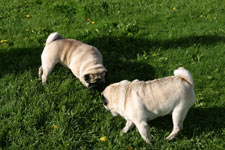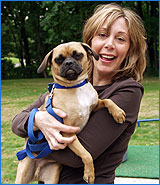Pug Dog Breed
Dog Group: Toy Group
Class: Toy
Description

The Pug is a small but very sturdy and stout little dog, with a sleek, tight-fitting coat. The color of the Pug can be silver, black, fawn or apricot, and the dog’s dark, wallowing eyes gives it an intelligent and thoughtful expression.
The Pug has a short muzzle, a broad black nose, and small, very soft pendant ears. The tail is distinctive by its tight curl.
Temperament
The Pug is a very intelligent, loving and affectionate breed, with bags of character and loyalty. A curious dog, the Pug does have a cheeky and often willful streak, but is also very charming and playful. This breed gets on well with other pets, other people and with children, and also loves attention. The Pug makes a good family dog, and will offer love, companionship and entertainment.
Height and Weight
The height of the average male Pug will reach around 12-14 inches, with females reaching around 10-12 inches. The male Pug averages around 13-20 pounds in weight, and females around 13-18 pounds.
Common Health and Behavioral Problems
The short muzzle of the Pug can cause breathing problems and wheezing, as with other short-muzzled breeds. The breed is also prone to eye and skin problems as well as allergies. The Pug can become very jealous if neglected, so it is important that you pay him a lot of attention to avoid behavioral issues.
Ideal Living Conditions
The Pug is well suited to either an apartment or house, and does not necessarily need a garden as long as he gets regular exercise. The breed is sensitive to extreme temperatures, and must therefore be housed somewhere that is not too hot or too cold.
Exercise Requirements
The Pug does require regular exercise and is an energetic little dog. He will enjoy regular walks and interactive games with his owner or family. You should be very mindful of the breed’s wheezing and breathing problems that stem from the short snout. Keep exercise moderate and not strenuous, and don’t exercise your dog in extreme temperatures.
Diet and Nutrition
Pugs can be greedy little dogs, and can put on weight easily. You should carefully monitor their food intake, and resist the temptation to feed them scraps between meals. Feeding them a moderate portion of dry food twice daily will help to keep the mouth and gums healthy as well as keeping the weight off. Always provide fresh, clean water for your dog.
Life Expectancy
A healthy Pug can expect to live for around 12-15 years. You can maximize on the lifespan by providing the Pug with a healthy diet, moderate but regular exercise and a generally healthy lifestyle.
Grooming Requirements
Grooming is relatively simple for Pugs. A quick brush with a firm bristle brush should keep the smooth coat in good condition. However, you should make sure that you clean the facial creases as these can gather debris and bacteria otherwise. Shampoo if required, but not too regularly as these dogs are susceptible to skin problems.
Origin
The Pug originates from China, and is thought to have been around for many centuries – possibly the descendant of the Tibetan Mastiff. The breed was introduced to Holland by Prince William of Orange in the sixteenth century. Prince William then went on to rule England, and the breed became popular there. After Americans began to ship Pugs over from England, they also gained popularity in the United States. The American Kennel Club first registered the breed in 1885.
 |
 |
Secrets to Dog Training Testimonials
 "My husband and I adopted Jack (a one year old male Pug/Chihuahua mix) three months ago from a shelter (we are his third home in a year) and to put it mildly he was 20 pounds of terror-- dominate, nipping, chewing and also had separation anxiety issues. He quickly earned the name 'Jack The Nipper'. I read a couple of books about dogs behaving badly, but felt that I needed a step-by-step approach to correct Jack's unpleasant behavior. I researched the internet and came across Secrets to Dog Training, which I quickly downloaded, printed and read in one evening.
"My husband and I adopted Jack (a one year old male Pug/Chihuahua mix) three months ago from a shelter (we are his third home in a year) and to put it mildly he was 20 pounds of terror-- dominate, nipping, chewing and also had separation anxiety issues. He quickly earned the name 'Jack The Nipper'. I read a couple of books about dogs behaving badly, but felt that I needed a step-by-step approach to correct Jack's unpleasant behavior. I researched the internet and came across Secrets to Dog Training, which I quickly downloaded, printed and read in one evening.
I immediately started with the Alpha Dog lessons and got across to Jack that I am the Alpha Mommy. I had no idea that doing something as simple as making him sit before I put his bowl of food down would make a difference in how Jack viewed me.
Jack has made great progress. His has become confident, less anxious and likes to practice commands every day. We still need to work on a few areas, but it's only been less than three months! Jack is much happier knowing that we are the pack leaders who protect, feed and love him.
I recommend Secrets to Dog Training to everyone who has a dog as a companion. I have learned so much about dog behaviors and how to respond accordingly without yelling or intimidating. Thanks Dan for writing such a great learning tool!"
-- Susan Caruso (USA)
More Resources
 |
 |
Want to find out about more dog breeds? Search here or go to our Dog Breed index.
Got Dog Obedience Training or Problem Behavior Issues?
Is your dog trying your patience on a daily basis? Are you constantly faced with a dog that displays one of the following issues? To find the solution to your problem click on it.. you'll discover the answers to it and other common dog problems you may be facing.
This is the most comprehensive book on dog training and behavior problems around. Best of all... You can download this book to your computer and be reading and using the professionals training techniques in minutes.
About The Author
Daniel Stevens is the renowned dog trainer and author of Secrets to Dog Training: STOP Dog Behavior Problems!, one of the leading dog training guides on the market today selling over 25,743 copies (and counting). He currently heads the Kingdom of Pets dog training team.

